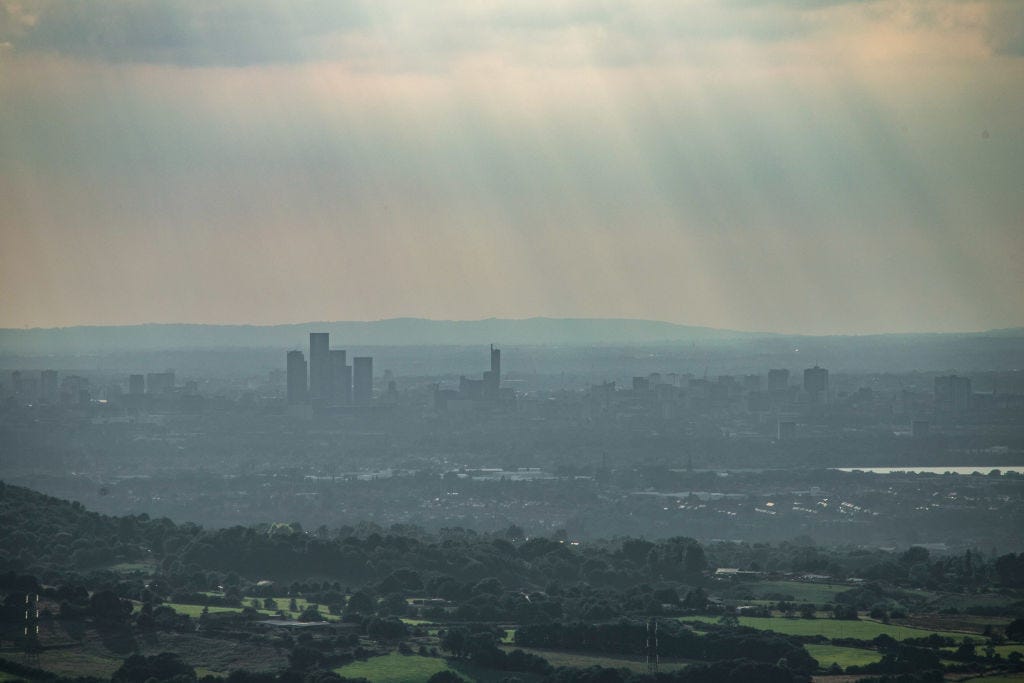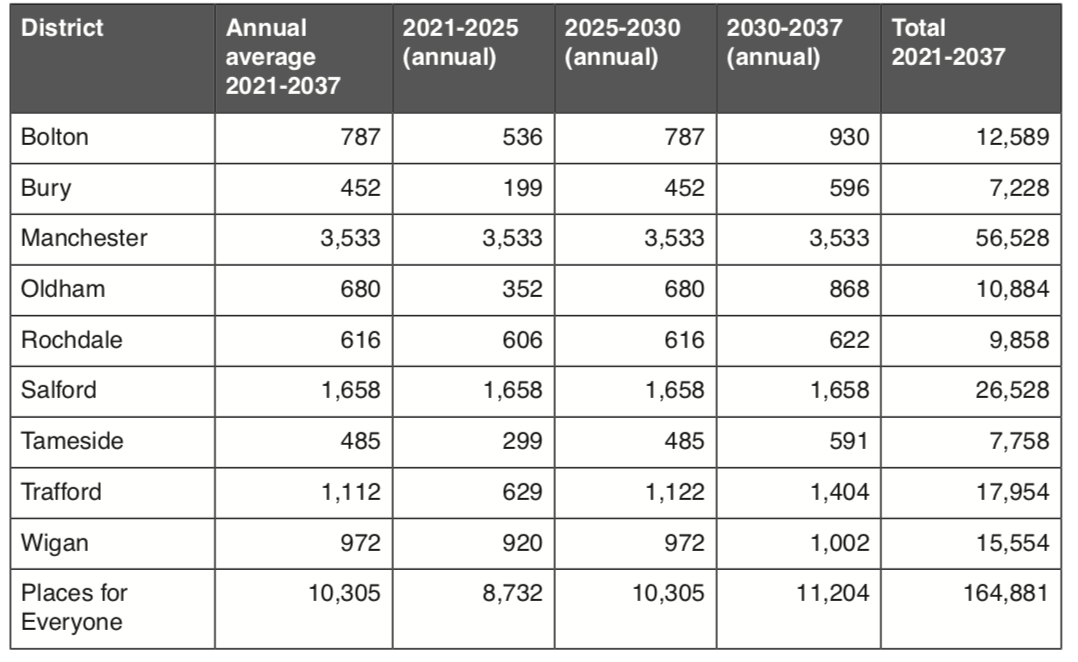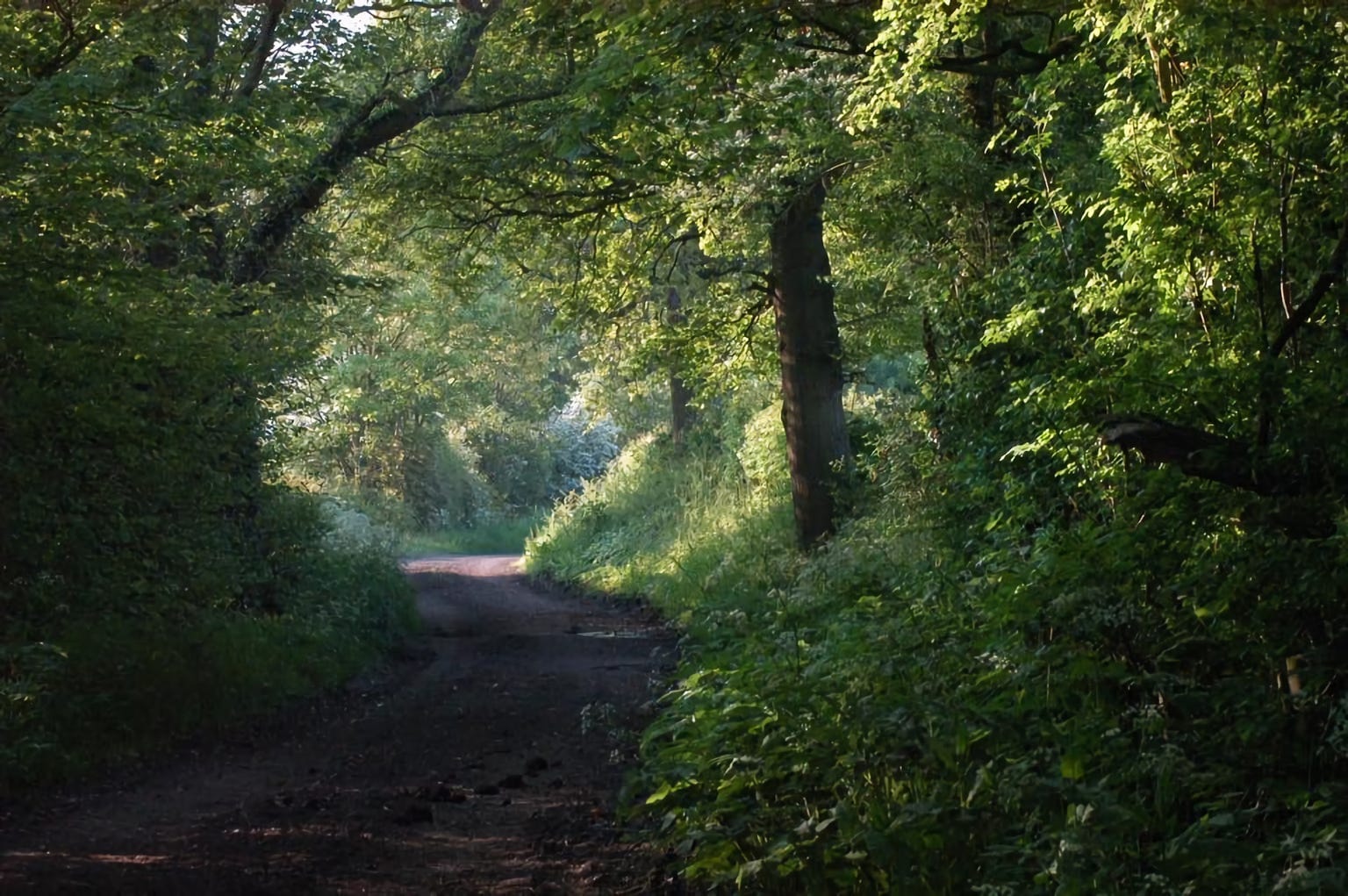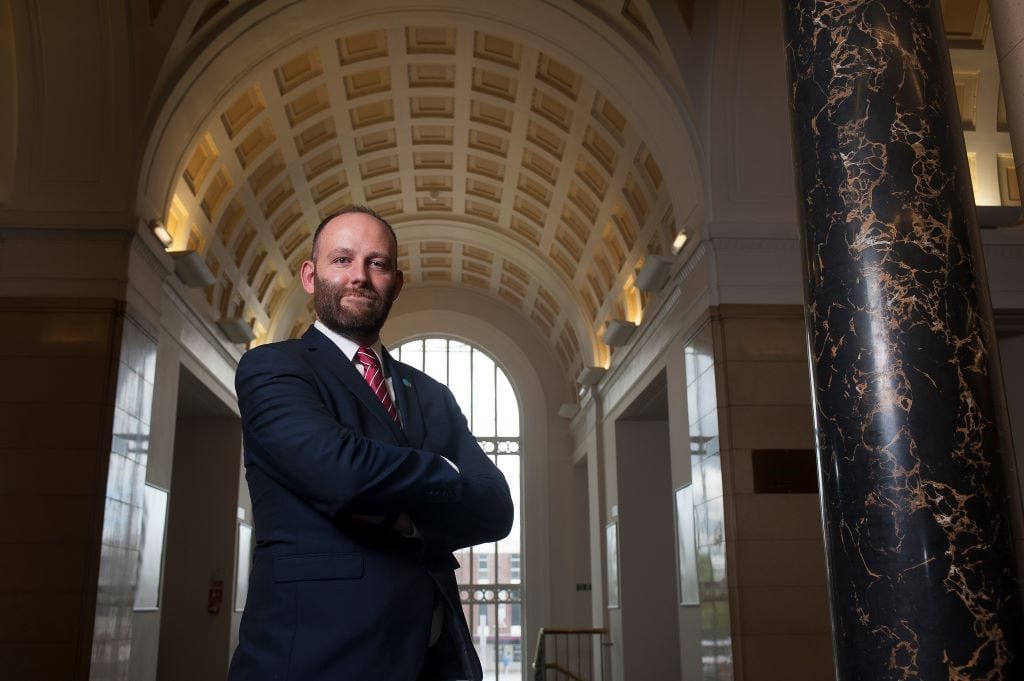By Alex King
Sir Richard Leese took one look at the gaggle of activists protesting outside Manchester Town Hall and decided to step in. The man who has led Manchester City Council since 1996 (and who recently announced he would be stepping down from the post in December) was on his way to attend a planning committee meeting. “You don’t care about green space,” one activist bellowed at him on a microphone. “Car parks is all that’s happened since the climate emergency was declared.”
Clasping a coffee and squinting in the sunlight, Leese began reeling off his counter-argument. “We’re building three large-scale new parks at the moment in the city,” he said. “We plant around 3,000 trees a year…” Soon he peeled off to attend the meeting, and heckling ensued. “You’re a red Tory!” one protestor yelled. “That’s why we’ve given up on Labour, because of you!”
The activists were there to protest against Manchester council’s planning committee which, they say, is not democratic enough. “Planning in Manchester is dictated from above,” one campaigner told The Mill. “During the judicial review of the council’s decision to keep parking facilities at the former Central Retail Park in Ancoats, the judge ruled Manchester council officers misled the planning committee. They also stated that Richard Leese and councillor Pat Karney tried to influence the planning committee,” she added. “It's not a fair system.”
The row outside the Town Hall shows just how salient the issue of planning — what we should build and where we should build — is in Greater Manchester right now. And one specific battle has been particularly prominent: for a few years, campaigners across the city region have been fighting tooth and nail, via popular Facebook groups and public events, to stop councils from releasing Green Belt land for development.
This month, those arguments come to a head as a grand plan called Places For Everyone moves towards its endgame.
‘A long-term plan’
Places For Everyone, out for public consultation until 3rd October, is officially “a long-term plan for jobs, new homes, and sustainable growth.” It decides what gets built and where in most of Greater Manchester between 2021 and 2037.
Local authorities are required by the government to submit Local Plans, which provide a framework for where development will be encouraged. As The Mill reported last year, the basic idea behind a co-ordinated plan is to get the Greater Manchester political universe to agree on a broad strategy for what should be built and where so that it can be signed off by central government, leaving local leaders in control of their own destiny.
However, Places For Everyone — formerly known as the Greater Manchester Spatial Framework (GMSF) — is highly contentious. This is because it releases large tracts of Green Belt land for development. That flash point largely explains why the plan has been a laborious five years in the making, and why Stockport pulled out of it last year.
Places For Everyone would release 1,754 hectares of Green Belt, which is roughly equivalent to 2,456 football pitches. For the nine boroughs under the plan this equates to a 3.3% reduction in the size of the Green Belt, compared to an 8.1% reduction that was envisaged by the first draft of the GMSF in 2016.

The Greater Manchester Combined Authority (GMCA) insists that, on balance, the plan will protect Green Belt from ‘speculative development’. Its rationale for this is that the National Planning Policy Framework (NPPF) requires councils to provide a five year supply of deliverable housing sites, based on an ‘objectively assessed housing need’ figure determined by central government.
The NPPF also establishes a presumption in favour of ‘sustainable development,’ reducing the effectiveness of Green Belt protections and removing the previous guidance emphasis on Brownfield first, the GMCA argues. “This reverses the traditional relationship between planning authority and developer,” Salford’s mayor Paul Dennett told The Mill. Dennett is also the GMCA’s lead on Places For Everyone, and argues that the plan protects residents from broader and less well-planned encroachments on the Green Belt. “Whereas before it was the responsibility of a developer to convince a planning authority that their development was in line with the desires of a local authority, now the burden of evidence falls on a local authority.”
By concentrating development more heavily in Manchester and Salford, Dennett argues the plan can take the slack off from other boroughs. “This has taken substantial pressure off the external boroughs of Greater Manchester,” he told The Mill, “who would otherwise be required to find a significant proportion of their local housing need on Green Belt land.”
The table below shows the distribution and phasing of new homes across the nine boroughs. You can see Manchester will accommodate the bulk of these (34.2%), with Salford a distant second (16.1%) and Trafford third (10.9%), followed by Wigan (9.4%), Bolton (7.6%), Oldham (6.6%), Rochdale (6%), Tameside (4.7%) and Bury (4.4%).

Without these plans, development needs are met through ‘speculative’ planning applications, Dennett says. “These are likely to identify more Green Belt locations than the Places for Everyone plan, as having a plan can illustrate how a coordinated approach, including brownfield focus, town centre regeneration and careful identification of the most sustainable Green Belt locations, will meet needs.
“Otherwise, planning applications are decided in the context of there being no plan and no wider strategy, and so developers can make a stronger case for more Green Belt (and other greenfield) releases to meet needs,” the mayor says.
Welcome to the Moss
Carrington Moss is a large area of peat moss and scrubland in rural Trafford occupying around 450 hectares. Originally an area of disused grouse moorland, it was reclaimed in the nineteenth century as a dumping ground for Manchester’s refuse.
Today the peat bog is replete with flora and fauna. Cranberry and bilberry pepper its vast tracts, varying the mass of ling and heather. There are more than ten sites of biological importance on and around the moss; it is home to some of the UK’s rarest birds, such as the willow tit, and endangered wildlife such as the water vole (both under serious threat from habitat loss).
For some, Green Belt like Carrington Moss stops urban sprawl and gives residents access to green space. “Green Belt is an amenity,” local Conservative MP for Altrincham and Sale West Graham Brady told The Mill, “a place where people can enjoy the outdoors, play sports, go walking, walk the dog — whatever it may be.”
But GM leaders see the development of Carrington, the area around the moss, as key for the city region’s economic growth, identifying it in Places For Everyone as a “significant opportunity” for a “transformational mixed use development.”
The plan puts forward a New Carrington Allocation plan. The plan encompasses the development of brownfield sites like the former Shell Carrington industrial estate. But in order for development to be “sustainable” and “inclusive”, the GMCA insists, the “release of some Green Belt land” is necessary. 169 hectares (37.5%) of Carrington Moss will be sacrificed to build 4,300 homes and around 350,000 square metres of buildings for industry and warehousing.

Brady opposes the release of Green Belt in his constituency. “Releasing it strains local infrastructure, with more intensive occupation, and implications for air quality for the services that people use. There’s more pressure on local doctors’ lists and school places — all of those things. And then, of course, there’s the congestion and straightforward traffic implications.”
The Green Belt and protected open land in the New Carrington Allocation is all open landscape woodland, with pockets of scrubland, which, if not pretty, is at least important for precious wildlife like the willow tit.
To be sure, not all Green Belt can accurately be described as bucolic or ecologically bountiful. “People think of [Green Belt as] rolling hills or they imagine agricultural land as much greener than it is,” journalist John Elledge told The Mill, “when actually much of it is chemically drenched monoculture.” In his newsletter, Elledge argues that we should reconsider the Green Belt, and make more distinctions about the land we are talking about. MPs like Siobhan McDonnagh agree with Elledge, sharing pictures of disused petrol stations on land technically classified as Green Belt.
“I think we need to change the classifications,” Elledge argues. “Green Belt suggests a particular thing. But it includes bits of urban land where the housing estate peters out and there's a wooded clearing where you and your mates got stoned when you were 16. Reclassify some of it as lovely green land, and some bits as semi-urban scrubland.”

But Green Belt advocates say this obscures why we have Green Belt. “The point of Green Belt is not related to landscape characteristics or biodiversity, but where it is spatially — near to large conurbations of people who benefit from it,” Jackie Cowley, planning Manager at the Campaign to Protect Rural England (CPRE), told The Mill. “In CPRE’s view the GM Green Belt is very important. It is located where people can go and unwind on a walk or cycle in locally accessible green space.”
Nowhere is the Green Belt debate more heated than in Bury, where local activists have been fighting the GMSF and now Places for Everyone vociferously for years. The plan envisages the release of 519 hectares of Green Belt for housing and industry in the Elton reservoir, Walshaw and Simister areas. “Elton reservoir has been there I think since the 1800s,” Stephen Cluer told The Mill. “It's the central point for leisure activity for the people at Radcliffe.”
Cluer says Radcliffians — who have lost many local facilities thanks to government cuts — rely on Green Belt for health and wellbeing. “Local resources like the leisure centre, the library, the town hall have all been removed,” he explains. “They've pretty much only got Elton Reservoir, which is literally in the middle of all the housing estates — everybody uses it. If 1,600 homes get dumped on it as Places For Everyone proposes there will be nowhere to go. They'll have literally taken the green lungs out of Radcliffe.”
Brownfield first
“The numbers don’t lie,” Cluer says over the phone. “People lie.” For many, simple maths tells us that GM’s Brownfield sites — land that has had a previous use and might be contaminated — can meet the conurbation’s housing needs for the foreseeable future, meaning we don’t need to touch Green Belt.
Places For Everyone forecasts a population increase of 190,000 between 2021 and 2037. Current housing occupancy rates in GM average at 2.38 people per house. Going off population increase, rather than what the government is asking for, then, Places For Everyone should plan for 79,831 homes.
What’s more, the plan states that Greater Manchester’s current brownfield land can supply 135,140 homes. So, in principle, the conurbation’s current brownfield land supply alone could meet the city region’s housing requirements until 2037. But the Plan allows for a total housing supply of 190,752 houses to be built between 2021 and 2037 — necessitating the release of Green Belt land, it contends.
The Mill put this to Dennett. He insists the GMCA’s hands are tied because it has to meet government housing targets. “Housing numbers are provided to us via government using their own methodology, over which we have no influence,” the Salford mayor says. “The housing numbers in the plan are based on the government standard methodology to calculate Local Housing Need.”
However, Sir Graham Brady is adamant those housing targets are not sufficient justification to release Green Belt. “I think the fundamental point in this is that the National Planning Policy Framework (NPPF) really puts a very high priority on saving Green Belt, and says there has to be an exceptional justification for getting rid of Green Belt designation.

“An exceptional justification can't simply be a rolling five year demand for housing — there's nothing exceptional about that,” he argues. “The amount of brownfield land available, I think, ought to obviate the need to do that [release Green Belt]."
Paul Dennett dismisses Brady’s points as disingenuous. “With all due respect, Conservative MPs are either ignorant of the planning system or being deliberately misleading if they are telling you that their government is not pressuring Councils to release Green Belt land for development.”
In any case, it’s not quite as simple as saying GM has enough Brownfield sites to meet housing needs. It’s also a question of whether we have the land in the right places to build houses; even if mathematically we could build enough homes on Brownfield sites, it wouldn’t necessarily be appropriate, either because they’re unattractive or unsustainable places to live.
“Homes near public transport nodes mean fewer cars and greenhouse gas emissions than if those people lived in suburban sprawl only accessible by car,” environmental campaigner Charlie Baker told The Mill.
“Losing some natural assets in urban locations excites a lot of fierce reactions but needs to be seen in a wider context — the carbon footprint of houses on the outskirts of Greater Manchester, compared to decent density within it, can easily eclipse the carbon lost in those assets — especially given the larger land take for suburban housing on green field sites with all their flora and fauna.”
“There’s a risk that defending green space without considering the wider effects looks like an eco-nimbyism that risks expanding the cities and doing far more harm.”
What happens now?
Public consultation closes on 3rd October. You can have your say here.
Once the consultation has closed, the GMCA says it intends to submit the plan to the housing minister, together with all the supporting documents and background evidence and any representations received during this final stage of consultation. Independent Inspectors will then be appointed to undertake an independent examination into the plan.
The government has set a deadline for all local authorities to have an up to date plan by December 2023.
Have your say: We would like to hear from Millers about this subject, so you can inform our ongoing reporting. Please hit reply or email editor@manchestermill.co.uk.

Comments
How to comment:
If you are already a member,
click here to sign in
and leave a comment.
If you aren't a member,
sign up here
to be able to leave a comment.
To add your photo, click here to create a profile on Gravatar.






